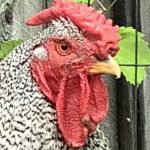
Winterizing your Livestock! How do you do it safely?
-
Winterizing your Livestock! How do you do it safely?
Posted by Data on August 31, 2022 at 12:35 pmHow do you Winterize your Livestock? What precautions do you take and how do you maintain your flock though a harsh winter?
-
This discussion was modified 2 years, 3 months ago by
 Data.
Data.
mlthompson replied 2 years, 2 months ago 12 Members · 25 Replies -
This discussion was modified 2 years, 3 months ago by
-
25 Replies
-
Unknown Member
MemberAugust 31, 2022 at 12:47 pmGreat question! I do not know, but always wondered. I grew up and my uncle was a cattle farmer, they were in a huge barn in the winter with a cemented paddock during nicer days. I personally, would probably make it very cozy for them, but I know others have different ways. But then again, I would love my kids…I know, people do not understand that, but I love them. I would just eat plant protein which actually has far more absorption of a greater content of more of the amino acids required, with greater digestion and overall health. But I get it…and this is a great question no matter, as the kids need winter protection. 🙂
-
I just got chickens here in Western Washington state and currently researching what to do to protect them from rain , wind and snow. What ever I do needs to be temp and able to be moved. Any suggestions welcome and pictures please🙂 would help. I am single and have to build myself.
-
We started off with a smaller coop we built from scratch, but decided it was too small for the number of birds we’d like to maintain. So, we decided to convert our shed into a coop!
-
What breed did you go with?
Your climate should be a big deciding factor in choosing a breed.
In a nutshell, smaller comb and wattle are less prone to have issues with frostbite in cold climates.
Larger comb and wattle are capable of cooling themselves more efficiently in warmer climates
-
Howdy Know-Place-Like-Homestead! It’s hard to say as the flock is really a mixed breed, we got from Tag n Bee a while back. There’s several Turken Naked Necks and I’m not sure what the rest are. Several with feathery feet and puffy cheeks! I’ll try and post some picture of them later.
-
-
-
My beautiful bride is the same way Deb! She thinks of them all as her babies! We live in NE Kansas and this will be our first winter with chickens as well. I bet we have a few Experts in the group that can weigh in on this for us!
-
We use a heated nipple waterer from premier one supplies and collect eggs at least twice a day. We also use deep bedding of pine shavings or straw and clean out the coop once a year in fall. We use a light on a timer to keep our hens laying throughout the winter. Make sure your coop is draft free( meaning no holes for air to come in the coop at chicken level) but also has adequate ventilation(hardwire cloth covered holes above the highest roost in your coop so air won’t blow directly on your chickens). And we cover windows with plastic. Our coldest temp last winter was -20 Fahrenheit and our chickens stayed healthy and frostbite free🐓🐔❄️
-
We have done different things on different years. When we first started, we used a mobile chicken tractor, Joel Salatin style. During the winters of 2013 and 2014 it was unusually cold here, got down to -35, brr. During those frigid temps we moved the chicken tractor inside the barn and tarped the top to help keep heat inside. Now we have a larger coop with electricity inside so we keep a heat lamp on during the coldest times and put a regular light bulb inside a cinder block on the floor that we put the waterer on top of to keep it from freezing.
I have a friend in North Dakota who built hoop house coops for her birds and that works really well for them.
The other animals we deep bed inside the barn during the coldest part of the winter.
Look forward to seeing what else others do.
-
Our birds are 100% free range. They live in the barn with the cows and the cats. They have free range of the yard whenever they choose. We have a”doggie door” for them to use when the barn doors are closed. Works out great. If they get cold they just snuggle up with the cows. It’s hilarious to watch them. Dogs are there to walk the perimeter of the property and keep everyone safe.
-
I also make sure I have a few months supply of chicken feed and other supplies I may need because I don’t want to run out when a big snowstorm hits and we are snowed in. Another thing to think about is setting out mouse/rat traps if you need them because rodents can become a bigger issue in the wintertime.
-
Great point about having enough feed on hand. Because of supply chain issues this year we also added extra things to our garden specifically to feed the birds if shortages become a problem. We grew extra winter squash and okra etc, added a meal worm farm, put extra comfrey in the greenhouse and have some extra wheat and barley to sprout and grow grasses through the winter for them. If you happen to keep a milk cow, chickens love clabber too and even if dry through the winter months, you can freeze or freeze-dry the extra skim milk through summer and fall to ferment through the colder months.
-
-
Deb, my chickens are under a carport which is enclosed with wire. In the winter, I buy heavy duty plastic and staple it over the wire. Your temps are much higher than mine so I would stack bales of grass hay and cover with tarps or the plastic. Hay bales add insulation. Grass hay can also be used for bedding. They are both easily removed. We have hot, humid summers which means I have to remove the plastic every spring. Plus the grass hay is used in the garden as mulch and composted. My hay was 6.00 a bale and never been sprayed. I am on tight budget. LOL
-
I did that with the straw bales last year-got bales for $2, they are $10 a bale this year. I’m trying to figure out something else this year. Also, we usually have a fairly mild winter here, but hearing a lot of folks saying we will have a bad one this year. Another thing I read somewhere and did last year is that whole corn, when fed late in the day before going to roost, helps to keep them warm.
-
-
Lot’s of good info on this thread Here are my two cents. For any livestock, make sure they have access to unfrozen water and good wind break. Most animals can handle the cold pretty well. In the 10+ years we’ve been doing this, we’ve only lost one animal to the cold., and that was in the middle of a blizzard. I am more worried about the heat, to be honest. Lots of straw on the ground or in nesting boxes for warm bedding; they will snuggle in to it to keep warm. Use the deep litter method and don;t worry about cleaning it up until the spring. If you can, a heat lamp in the coop or loafing shed doesn’t hurt. Be sure to buy a good one and follow safety measures. For chickens, a lamp in the coop will keep them laying through the winter, as well as keeping them warm(ish) . You need to check on them more often, especially if you are not using a trough deicer of a water warmer. Finally, birthing can be harder on the flock in cold weather. We screwed up a couple of years and had lambs and kids in Jan and Feb, so the mortality rate was higher than normal. Again, check them more often and watch for anything out of the normal.
-
Great information. I have noticed my chickies don’t mind at all running around in the rain or the snow. I worried about the heat also. My son who is an electrician, got a fan and installed it in my coop that had been pulled out of a huge freezer. It helps.
-
-
-
You can also stack straw bales along the walls of your coop and I hang a small curtain around the small door the chickens use that allows for the chickens to pass through but helps keep out some of the cold wind (picture). Covering the coop windows at night with some type of curtain would also help keep the coop warmer.
-
This reply was modified 2 years, 3 months ago by
 Susquehanna-Homestead.
Susquehanna-Homestead.
-
That is an awesome doggie door and information, thanks for sharing!
-
This reply was modified 2 years, 3 months ago by
-
For our chickens.. We put plastic on the back side of the coop and windows. We use a heat lamp on a timer for the coldest day/nights. Heat lamp comes on w the timer. On one hour,,,off for two, depending on the low temp . No need to keep it on all night or day. Not in NH anyway. It helps to have birds that are hearty for colder weather. We go with heritage birds like NH reds,Buff orpington ect. Its better to have birds that have smaller combs so they dont get frost bite as easy. When the snow gets to deep they tend to stay “inside” They have a large indoor run Attached to the coop so they can get “out”. We use a heated water keeper to stop their water from freezing. We converted our now grown children’s swing set into a chicken coop. Its the type that looks like a fort. The fort area is the chickens coop. Roost and egg boxes. The run extents from under the “fort to where the swings were. The run is enclosed in chicken wire and screened in. We plastic the screened area in the winter to keep the snow out.
-
With the onset of cold weather, here is some handy information on protecting your flock! This is our first year with chickens, so we’re hoping for the best, planning for the worst.
Chicken Frostbite — Treatment & Prevention – Backyard Poultry (iamcountryside.com)
Log in to reply.

